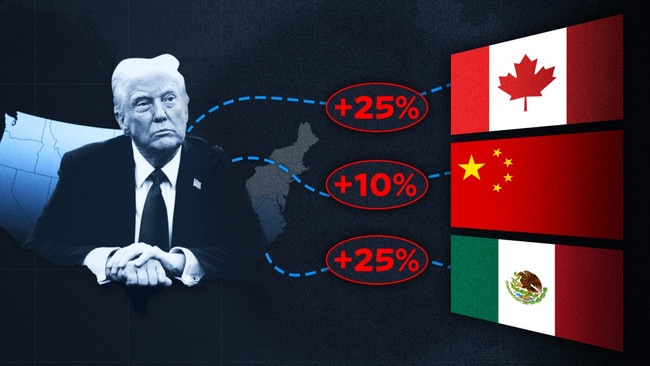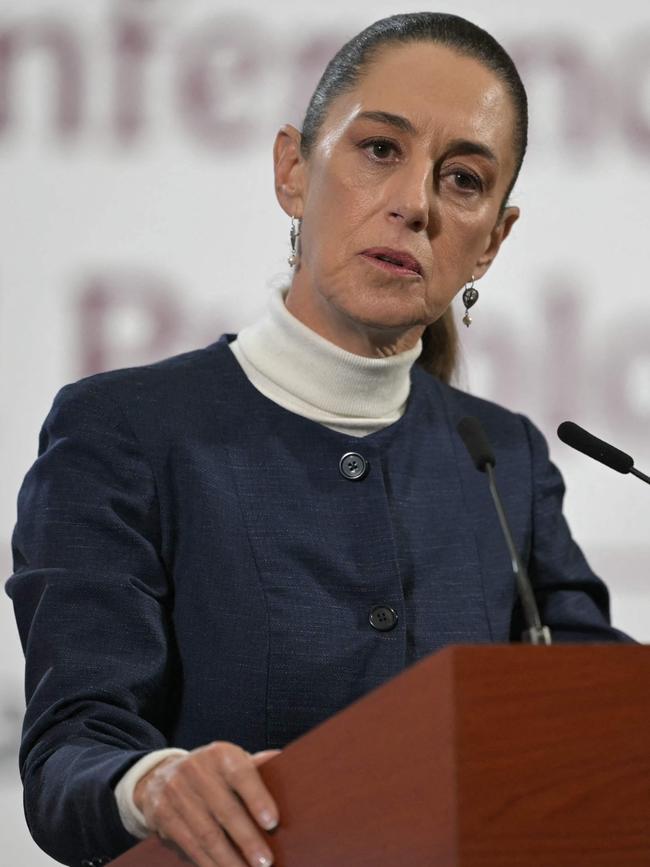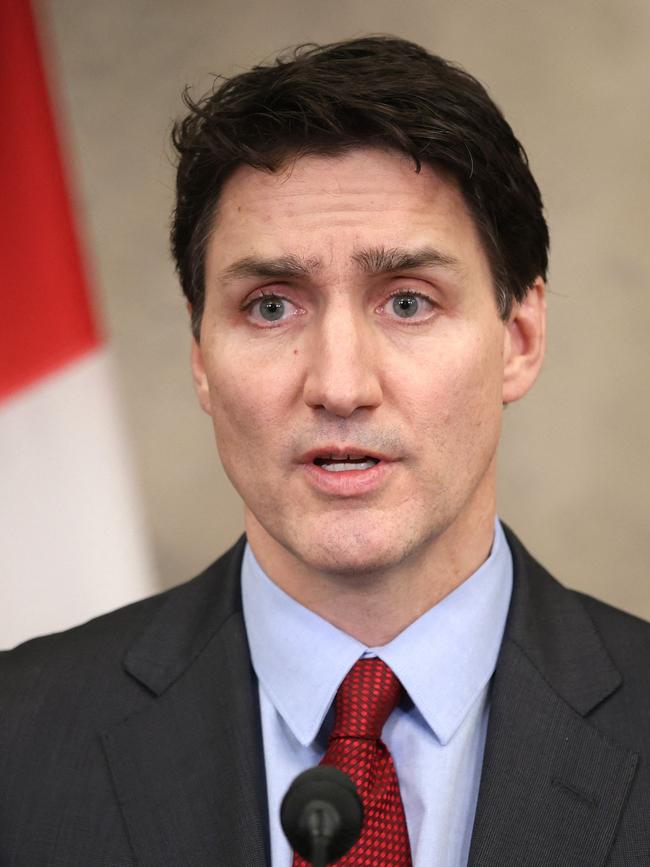
At the weekend, Trump conceded Americans could be hurt. He posted: “Will there be some pain? Yes maybe (and maybe not!)” – but don’t worry because “it will all be worth the price that must be paid.” There were immediate signs of that price, given the hit on the sharemarket, corporate warnings that US prices would rise, that supply chains would be up-ended and statements from Mexico’s President, Claudia Sheinbaum, and Canada’s Prime Minister, Justin Trudeau, spelling out their damaging retaliation against the US that would mean lost jobs and higher costs.
The episode proves tariffs are fundamental to Trump’s governing beliefs and that his trust in tariffs is dangerous for America and the world. Trump sees higher tariffs as a core economic goal and as a lever to extract concessions from other nations. Both aspirations are flawed – high tariffs are a de facto tax on the American people that will drive higher inflation and damage global growth. By declaring a win with his opening tariff ploy Trump was ever the showman, addicted to brinkmanship and guaranteeing this is merely the start of his tariff revolution.
Here is Trump’s idea of a good deal: threaten a trade war to get concessions on reducing flows of fentanyl and illegal migrants at the US border. But cause and effect doesn’t work. Illegal drugs have flowed into the US for decades because of American demand. The idea tariffs will stop the drugs – by delivering extra preventive measures – is, frankly, absurd.
What’s not absurd is the populist politics sure to boost Trump. After it works once, you repeat the ploy. And promote the optics – the American strongman humbling the leaders of Canada and Mexico. While pausing his 25 per cent tariffs against both nations, Trump keeps the threat alive pending any final deal. The three leaders can say everyone’s a winner, while Trump entrenches uncertainty and intimidation.


If this was merely the tariff as a negotiating instrument, the consequences might be tolerable. But, of course, it’s not. Trump is a believer in higher tariffs – a commitment integral to his “Make America Great Again” credo and his nationalistic quest to re-industrialise America. His purpose is to attack and bury the collapsing global free trade model, already substantially undermined by China.
For years Trump has ranted against American bilateral trade deficits; above all, with China. He hates deficits as such – it doesn’t matter whether the trade deficit is with a rival or an ally. On any rational basis, picking a fight with Canada and Mexico makes no sense. But in Trump’s bizarre world, it makes perfect sense.
It’s almost as though he sees a trade deficit as a sort of US subsidy to other countries.
In its editorial The Wall Street Journal said: “Mr Trump sometimes sounds as if the US shouldn’t import anything at all, that America can be a perfectly closed economy making everything at home. This is called autarky, and it isn’t the world we live in, or the one that we should want to live in, as Mr Trump may soon find out.”
Trump’s mission is to cancel the existing order. In his inauguration address he said: “I will immediately begin the overhaul of our trade system to protect American workers and families. Instead of taxing our citizens to enrich other countries, we will tariff and tax foreign countries to enrich our citizens.”
It sounds like a policy. To this purpose, Trump said an External Revenue Service would be created “to collect all tariffs, duties and revenues”, with such “massive” moneys “pouring into our Treasury” from foreign sources. This is exactly what it sounds – a supposed policy to reduce America’s trade deficit with many nations, to bolster its revenues thereby creating scope for domestic tax cuts, and to extract concessions from other countries to enhance US power and territorial ambitions.
If this summarises Trump’s replacement world order, it is built on quicksand. Consider a slight problem – it is US importers who pay the tariffs, not foreigners. But that cannot diminish Trump’s infatuation. “Tariffs are the greatest thing ever invented,” Trump said in the campaign. His attitude verges on romance. Trump says tariffs “are the most beautiful words to me in the dictionary”. He says tariffs come after God, religion and love. His views on the dividends from tariffs are delusional. Trump’s problem is that the faster he moves on tariffs, the quicker he accentuates the inflation risk.

At this stage Trump keeps his pledge of an additional 10 per cent tariff on China. At the weekend he said higher tariffs will “definitely happen” with the European Union, and “pretty soon”. Having a trade war with the EU makes no sense but Trump presumably will invest it with another purpose. Will he use the tariff threat to secure higher promises from NATO countries on the defence budget? Trump said at the weekend that America’s trade deficits with Canada and Mexico would need to be rectified before the tariffs were lifted. President Sheinbaum said that in her phone call with Trump agreeing the pause, Trump raised the US trade deficit with her. Of course he did. Nobody can say they weren’t warned.
For months before the election Trump’s trade retaliation threats were specific and his single most important economic pledge. Contrary to the claims made by Trump apologists for months – don’t worry about the tariffs, there’s no problem, they’re just a negotiating ploy by Trump to get his way – the reality is that on tariffs Trump has the will to power. As former Australian ambassador to the US, Arthur Sinodinos, told The Australian this week about Trump’s thinking on tariffs: “I think they are an end in themselves. We are very much into a new age of American protectionism, which will further impact global institutions and we’ll see to which extent it will lead to trade retaliation.”
This week’s events, however, show the disruption Trump cultivates can rebound against him. The allergic reaction of Wall Street, sharemarket losses and risks to the US household sector reveal higher tariff protectionism will deeply split US sentiment and carry a steeper domestic danger than Trump anticipated.
Trump’s extra 10 per cent tariff on China will apply to more than $400bn of goods America purchases from China, and has provoked Beijing to announce retaliatory steps, including tariffs on a range of US products. So, at what point might Trump engage China’s Xi Jinping in a phone call or a deal? The backdrop is Trump’s earlier threat to impose an extra 60 per cent tariff on imports from China, a move that would throttle the global economy.
The shift to a more protectionist world – which Trump has the power to deliver – will undermine Australia’s national interest, further compromise the cause of free trade and promote economic disruption that will work against Australia. Trump, in effect, asks other nations: What are you doing for America? China, by contrast, will merely tell other nations: Beijing is here to help you.
Australia might get an exemption because Trump is supposed to like us, and the US has a trade surplus with Australia. Who knows? There is one certainty; the more Trump pursues his tariff strategy, the more he will alienate other nations, compromise alliances and give China fresh opportunity.







Don’t fall for the drum-beating brigade pretending Donald Trump has won a stunning victory over Mexico and Canada. Understand what really happened – Trump retreated from a devastating lose-lose tariff agenda that would have damaged the North American continent and punished American consumers.